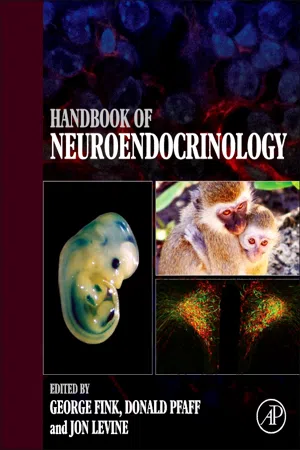
- 894 pages
- English
- ePUB (mobile friendly)
- Available on iOS & Android
Handbook of Neuroendocrinology
About This Book
Neuroendocrinology, the discipline concerned with how the nervous system controls hormonal secretion and how hormones control the brain, is pivotal to physiology and medicine. Neuroendocrinology has disclosed and underpins fundamental physiological, molecular biological and genetic principles such as the regulation of gene transcription and translation, the mechanisms of chemical neurotransmission and intracellular and systemic feedback control systems. Reproduction, growth, stress, aggression, metabolism, birth, feeding and drinking and blood pressure are some of the bodily functions that are triggered and/or controlled by neuroendocrine systems. In turn, neuroendocrine dysfunction due to genetic or other deficits can lead, for example, to infertility, impotence, precocious or delayed puberty, defective or excessive growth, obesity and anorexia, Cushing's Syndrome, hypertension or thyroid disorders. These as well as neuroendocrine tumors are some of the themes covered in the 36 chapters of the Handbook. Drafted by internationally acknowledged experts in the field, the Handbook chapters feature detailed up-to-date bibliographies as well as "how do we know?" call out sections that highlight the experimental or technical foundations for major concepts, principles, or methodological advances in each area. Aimed at senior undergraduate and graduate students, post-doctoral fellows and faculty in neuroscience, medicine, endocrinology, psychiatry, psychology and cognate disciplines, the Handbook of Neuroendocrinology satisfies an unmet need that will prove useful at the laboratory bench as well as in the office.
- The most comprehensive up-to-date source covering basic principles, neural regulation, hormone/brain function and behavior, and neuroendocrine pathology
- "How do we know?" callout sections highlight core concepts
- Heavily illustrated with over 350 figures, 4-color throughout
Frequently asked questions
Information
Table of contents
- Cover Image
- Table of Contents
- Front Matter
- Copyright
- List of “How Do We Know?” Boxes
- Preface
- About the Editors
- List of Contributors
- Notes on Nomenclature
- Chapter 1. An Introduction to Neuroendocrine Systems
- Chapter 2. Neuroendocrine GPCR Signaling
- Chapter 3. Neuroendocrine Feedback Control Systems
- Chapter 4. Evolution of Reproductive Neurohormones
- Chapter 5. Neural Control of the Anterior Lobe of the Pituitary Gland (Pars Distalis)
- Chapter 5. Neural Control of the Anterior Lobe of the Pituitary Gland (Pars Distalis)
- Chapter 6. Neural Control of the Posterior Pituitary Gland (Neurohypophysis)
- Chapter 7. Neural Control of the Intermediate Lobe of the Pituitary Gland (Pars Intermedia) and Proopiomelanocortin
- Chapter 8. The Hypothalamic–Pituitary–Adrenal Axis and Neuroendocrine Responses to Stress
- Chapter 9. Neuroendocrine Control of Reproduction
- Chapter 10. Lifetime Regulation of Growth Hormone (GH) Secretion
- Chapter 11. Neuroendocrine Regulation of Development, Growth and Metabolism – Thyroid
- Chapter 12. Circadian Rhythms in Neuroendocrine Systems
- Chapter 12. Circadian Rhythms in Neuroendocrine Systems
- Chapter 13. Cardiovascular Neuroendocrinology
- Chapter 14. Neuroendocrine Regulation of Food Intake
- Chapter 15. Neuropeptide Regulation of Stress-Induced Behavior
- Chapter 16. Neuroendocrine Regulation of Body Water and Electrolytes
- Chapter 17. Sexual Differentiation of Brain and Behavior
- Chapter 18. Corticosteroid Actions on Neurotransmission
- Chapter 19. Neuroendocrine Mechanism of Puberty
- Chapter 19. Neuroendocrine Mechanism of Puberty
- Chapter 20. Sexual Behaviors
- Chapter 21. Stress and Brain Function
- Chapter 22. Neuroendocrinology of Aggression
- Chapter 23. Chronic Social Stress
- Chapter 24. Estrogen and Cognitive Aging in Women
- Chapter 25. Hormones, Mood and Affect
- Chapter 26. Hormones and the Aging Brain
- Chapter 27. Kallmann Syndrome and Other Causes of Hypothalamic Hypogonadism and Related Development Disorders
- Chapter 28. Parental Behavior and the Perinatal Programming of Infant Development
- Chapter 29. Disorders of the Hypothalamic–Pituitary–Adrenocortical System
- Chapter 30. Disorders of the Hypothalamic–Pituitary–Gonadal Axis
- Chapter 31. Disorders of the Hypothalamic–Pituitary–Thyroid Axis
- Chapter 32. Neuroendocrine Growth Disorders – Dwarfism, Gigantism
- Chapter 33. Neuroendocrine Inherited or Induced Aromatase Enzyme Deficits
- Chapter 34. Pituitary Adenomas
- Chapter 35. Neuroendocrine Tumors
- Chapter 36. Psychoneuroendocrinology
- Subject Index
- Author Index
- Author Index
- Author Index
- Author Index
- Author Index
- Author Index
- Author Index
- Author Index
- Author Index
- Author Index